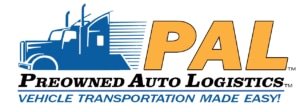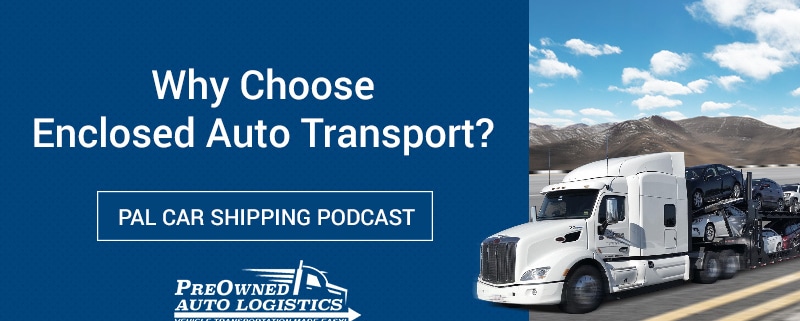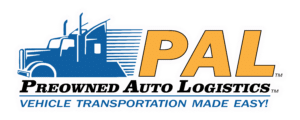Why Choose Enclosed Auto Transport? (Podcast)
Jeremy Louisos from Preowned Auto Logistics talks with John Maher about the benefits of enclosed auto carriers compared to open carriers. They look at differences in safety, price, and quality and discuss some situations where car owners should opt for enclosed transport.
John Maher: Hi, I’m John Maher and I’m here with Jeremy Louisos, Senior Vice President at Preowned Auto Logistics, a car shipping and auto transport and logistics company in Massachusetts. Today our topic is, “Why choose enclosed auto transport.” Welcome, Jeremy.
Jeremy Louisos: Hey John. Thanks for having me. Appreciate it.
Enclosed Car Transport Vs. Open Carriers
John: Sure. So, Jeremy, what is an enclosed car transport versus an open carrier?
Jeremy: We’ll start with open carriers. That’s really the standard mode of transportation for a lot of auto carriers. So if you’re driving down the highway and you see one of those trucks with cars hanging all over the place, that’s an open carrier. They’re secured to decks and rails, and they’re sort of up and encaged off of the road, but the sides are open. The vehicles are exposed to the elements and that sort of thing, as opposed to an enclosed carrier, which will quite often look just like a regular tractor trailer. You’ll see the hard sides. You might not even tell the difference between an enclosed trailer and just anyone hauling cargo. And it’ll have a fixed deck in the middle, as opposed to the trucks that we’ll, see the open carriers, they have these independent decks. You might see cars facing all sorts of different directions. On the enclosed carrier, it’s usually fixed decks. There’ll be a lower level that can fit a few cars and then an upper level.
How Do Cars Fit in Enclosed Carriers?
John: And how does the car fit under the upper level? Is there sort of a raised platform that can go up to that second level and then it drives in?
Jeremy: Yeah. Quite often these type of trailer is going to have a lift gate, similar to if you’re renting a U-haul and you can drop a gate down. It’s just going to be a bit longer to accommodate a vehicle. And it’s great for those low-clearance, low-profile, exotic or classic cars, where you need to not use a ramp. If you were to, the angle of that ramp might scuff the front of the underside of the vehicle. This lift gate will drop down, go right to the ground, drive the vehicle straight onto it. It’ll lift the vehicle up, keeping it parallel to the ground. You just drive right in to either the bottom or the upper deck.
John: So I might be driving by these types of enclosed car transportation trucks all the time on the highway, and not even know that inside that truck is a whole bunch of cars.
Jeremy: Yeah, that’s true.
How Many Cars Fit in Enclosed Car Carriers?
John: And how many cars typically fit into an enclosed car transport?
Jeremy: Typically, it’s going to be less than the open style. The open style we can get as many as 10, depending on the size of the vehicle. Those 10-car carriers, the really big ones, 80 feet long. These, it’s going to be, quite often, a few less. And the other constraint is, because of that fixed deck, you quite often won’t be able… In the larger trailers, you won’t be able to get an SUV or a truck, something that’s higher. That said, there are different versions of these trailers that, maybe they have the height, but they’re like a two-vehicle carrier where you can drive two in. That said, if you have something like a motorcycle or a smaller sports car, maybe you can do a little bit better and really pack them in there.
Why Choose an Enclosed Car Carrier Over an Open Carrier
John: Okay. So what are some of the reasons why someone might choose to have an enclosed car transport instead of an open carrier?
Jeremy: The biggest reason we see is, like we mentioned, with the open-style carrier, you’re going to be exposed… Because it’s encaged, but not closed off on the sides, you’re going to be exposed to the weather elements. You’re going to be exposed to possible road debris. There are a number of scenarios where the owners of these vehicles do not want the vehicles to be dirty. Perhaps they had a special type of recon done, or they were cleaned in a particular way. They just need to arrive at their destination fully clean on the exterior of the vehicle. And then if you have a very expensive vehicle, if you have anything exotic, classic, race cars, it needs to be pristine. You can’t risk that chance of anything popping off the road. A little pebble, if it bounces off most of our vehicles, I mean, we’re taking that risk when we drive on the highway anyway, but there are vehicles that are very rarely driven on the open road. If you’d be uncomfortable driving it that distance, enclosed is a good option for you. It’s going to protect it from all the elements and keep it nice and clean.
How Enclosed Carriers Protect the Interior of Vehicles
John: Do you ever have any situations where maybe somebody is shipping a car that maybe isn’t running or has something wrong with it, like maybe a convertible that somebody is having shipped to them to restore, but the top is missing or is broken or something like that? And so obviously you can’t ship a convertible with no top on it. It would get rained on and things like that. Have you ever encountered that sort of situation?
Jeremy: Yeah, absolutely. That would absolutely fit that criteria of a vehicle that cannot be exposed to any weather conditions. If there was a defect on a vehicle where if it was transported distance and there was just any chance of weather, you wouldn’t want to risk it. You’d want to make sure that vehicle was inside and protected from the elements, it would get to its destination safely, and they could do the repairs without any of that weather exposure risk.
Cost of Enclosed Carrier Vs Open Carriers
John: Right. Is an enclosed car carrier more expensive than an open one?
Jeremy: It is. Because open transportation is such a convention, there’s so many more of those trucks. There’s just far fewer options or trailers or folks that have that equipment in their arsenal. So because there are fewer of those, and the demand just is such that those end up being just a more expensive option. Plus, they can’t really ship as many at a time. There’s those restrictions with size. So taking all that into account, it’s a more specialized piece of equipment. Many parts of life, if you want the safest, highest-level customer experience, you’re going to have to pay a little bit more. It doesn’t make sense in every occasion. Quite often, open is just fine. It’s a good way to affordably ship something. But when the most important part of the shipment is keeping it protected, enclosed is your best bet. Quite often, our customers are more than willing to pay to get that service.
Enclosed Carrier Delivery Options
John: Right. And can enclosed car carriers deliver to both terminals, terminal to terminal, and also door to door, like right to my house? Are there any other considerations or things that I can’t get if I’m using an enclosed car carrier?
Jeremy: So the equipment they’re using is going to be very similar in height and length. So any restrictions we might see on an open carrier would just apply the same to the truck. Those trucks are, size-wise, very comparable. They can get in and out of the same location. If you would be uncomfortable having an open carrier arrive in a small residential neighborhood, needed to maybe arrange a terminal transport or meet at a nearest parking lot, you’d want to make those same accommodations with enclosed, but nothing really specifically different in the size of the truck.
John: All right. That makes sense. Well, that’s great information, Jeremy. Thanks again for speaking with me today.
Jeremy: John, it was a pleasure as always. Appreciate it.
Set Up Enclosed Car Carrier Service Today
John: And for more information, or to request a quote for your auto shipping needs, visit the website at PreownedAutoLogistics.com, or call (877) 542-1955.




